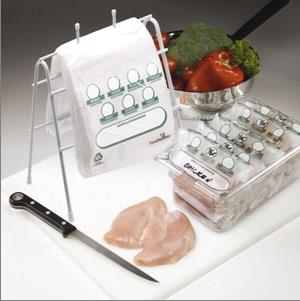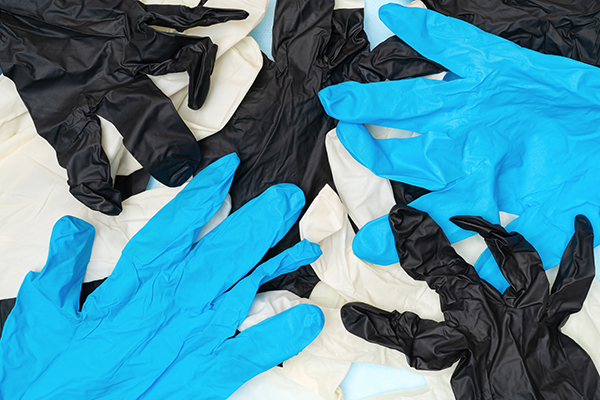Why Does Food Spoil?
 Food gradually deteriorates because of a natural process of aging, just like humans. However with all foods, there are a few things we can do that have a positive effect on the shelf life and safety of our foods at the restaurant. Some preservation is done at the food manufacturing plant, some naturally, but a better understanding of the processes may help you extend that shelf life. Preservation methods and storage conditions must be designed to reduce the rate of decomposition and protect the safety, appearance and taste of our food.
Food gradually deteriorates because of a natural process of aging, just like humans. However with all foods, there are a few things we can do that have a positive effect on the shelf life and safety of our foods at the restaurant. Some preservation is done at the food manufacturing plant, some naturally, but a better understanding of the processes may help you extend that shelf life. Preservation methods and storage conditions must be designed to reduce the rate of decomposition and protect the safety, appearance and taste of our food.
The causes of food spoilage – Plant and animal tissue starts to decay soon after raw food has been harvested or killed. The spoilage process is usually caused by microorganisms such as fungi (molds & yeasts), spoilage bacteria, and their enzymes. Not all these changes in food are undesirable. Some people like aged beef and cheeses or very ripe fruit. The production of wine and beer involves conversion of sugars to alcohol, while souring of milk is essential in the production of cheese.
However, it’s important to remember that some of the conditions that accelerate spoilage, such as inappropriate temperature and moisture control, also encourage the growth of pathogenic microorganisms that cause foodborne illness. Consequently, spoiled food is not just an issue of quality, it is also often a question of food safety.
Mold & Yeast: Corn, nuts, breads, meat, cheeses, fruits and vegetables are affected by mold. With most cheeses (i.e. cheddar, mozzarella, American, or Swiss), don’t try to salvage cheese that shows visible mold by cutting it away unless it’s a natural part of the cheese like bleu cheese, Brie, or Camembert. Mold forms a network of microscopic strands that extend into the foods which could cause allergic reactions or illness, so discard them. Most cheeses don’t improve with age. Deli meats are the same. Yeast can cause discoloration, slime, and odors on sweet, acidic refrigerated foods or jams/jellies.
 Bacteria: Some spoilage bacteria are also pathogenic (disease causing). For example, Clostridium perfringens (a common cause of spoilage in meat & poultry) and Bacillus cereus (spoils milk & cream) are also responsible for causing foodborne disease. Most foods are subject to bacterial growth.
Bacteria: Some spoilage bacteria are also pathogenic (disease causing). For example, Clostridium perfringens (a common cause of spoilage in meat & poultry) and Bacillus cereus (spoils milk & cream) are also responsible for causing foodborne disease. Most foods are subject to bacterial growth.
Enzymes: They are naturally present in the cells of microorganisms that break down animal and plant foods. Breakdown continues until the enzymes are inactivated by blanching or cooking.
Other causes of spoilage include: 1) bruising or piercing because of rough handling such as vegetables, fruits or vacuum packaged food; 2) oxidation (changes the taste or texture when exposed to oxygen) or freezer burn; 3) pest infestation because of poor receiving control, storage, rotation or cleaning; 4) adulteration by addition of leftover food to fresh food, inferior or undesirable food or ingredients.
Detecting spoilage includes the typical indicators such as appearance (discoloration or slime), texture, smell or taste (obviously not recommended if any of the others are present).
Bottom line – When in doubt, throw it out. Food spoilage does affect your bottom line in food waste dollars, so prevention includes good receiving inspection practices, following manufacturer’s instructions, utilizing innovative active packaging or food storage bags, unfailing temperature recording and control, being observant and certainly good sanitation and personal hygiene by food handlers.
***
About the Author: Lacie Thrall

READ MORE POSTS
Addressing Major Food Recalls in Your Business
It seems like every year we have a large-scale food recall that reminds consumers and foodservice operators about the importance of food safety. Not that we need reminded, but it certainly puts the topic in the headlines again. Last year, it was the onion recall. This year, it may very well be the Jiff peanut butter recall, of which we are in the midst of. At the time of the publishing, we are starting to learn more about a potential hepatitis A outbreak linked to strawberries. If you have not been impacted by either of these recalls in your personal or business life, I would be surprised.
Sanitation, Sanitation, Where Art Thou?
Continuing the theme I picked up on a few months ago, discussing common causes of foodborne illness, I’d like to focus this blog on cross contamination, more precisely sanitation. Sanitation is another issue that employees don’t often do at home, so they discount the importance of it in the food production environment. That is to say that they have never made someone sick at home because they only clean their countertops and they have likely never sanitized their kitchen, so why is it so important in a foodservice facility?
Handwashing: The Habit that Isn’t as Common as We May Think
Earlier this year, I started to focus our FoodHandler Food Safety blogs on common food safety issues faced in each foodservice operation across the world. We’ve covered some of the most common issues, but perhaps none is more common than improper hand hygiene.
Is Implementing a Color-Coded Food Safety Plan Right for your Operation?
Foodborne pathogens are by far the most prevalent cause of foodborne illness in the United States and across the world. There are 31 known agents that cause foodborne illnesses, and more that are unspecified or yet undiscovered – remember, E. Coli 0157:H7 wasn’t identified until the early-1980s. It is estimated each year, 48 million illnesses occur because of these known and unknown pathogens, resulting in over 3,000 deaths.










